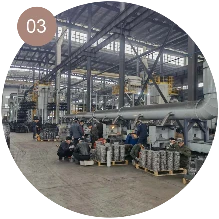
antique cast iron frying pans
The Allure of Antique Cast Iron Frying Pans A Culinary and Historical Journey
Collecting antique cast iron frying pans is more than just a hobby; it's an exploration of history, craftsmanship, and the enduring appeal of cooking with seasoned iron. These heavy-duty cookware pieces not only serve as exceptional kitchen tools but also tell fascinating stories about the lives and traditions of those who used them.
Cast iron frying pans have been a staple in kitchens for centuries, with origins tracing back to ancient China and eventually spreading to Europe, where they became popular in the 18th and 19th centuries. The manufacturing process was labor-intensive, involving skilled craftsmanship, which is evident in the intricate designs and durable construction of antique pieces. Unlike modern cookware, which often features non-stick coatings that can wear off, antique cast iron pans, when properly cared for, can last for generations and often improve with age.
One of the remarkable features of antique cast iron frying pans is their ability to retain and evenly distribute heat. This characteristic makes them perfect for various cooking methods, from searing meats to baking cornbread. The natural non-stick surface achieved through seasoning adds to their versatility, allowing cooks to prepare a wide range of dishes without fear of sticking. For many, the journey of seasoning a cast iron pan becomes a cherished ritual, creating a deep connection between the cook and their cookware.
The hunt for antique cast iron frying pans can be an exhilarating journey. Yard sales, flea markets, and antique shops often yield hidden gems waiting to be discovered. The thrill of finding a well-worn skillet that has stood the test of time is akin to unearthing a piece of culinary history. Collectors often look for specific brands, such as Griswold, Wagner, or Lodge, each known for their quality and unique designs. Some pans feature distinctive markings, such as logos or patterns, which not only enhance their aesthetic appeal but also provide insights into their history and manufacturing origins.
antique cast iron frying pans

Caring for antique cast iron frying pans requires a bit of knowledge and dedication. Unlike modern pans, antique cast iron needs to be seasoned regularly to ensure it retains its non-stick qualities and prevents rusting. Cleaning methods vary, but many enthusiasts recommend avoiding soap, opting instead for hot water and a stiff brush. After drying, it's important to reapply a thin layer of oil to maintain the seasoning. This ritual not only preserves the pan but also connects the modern cook to the practices of their ancestors.
As the world becomes more health-conscious, many home cooks are rediscovering the benefits of using cast iron cookware. Antique frying pans often contain fewer chemicals than their modern counterparts, making them a safer option for cooking. Additionally, many antique cast iron pans are believed to add trace amounts of iron to food, potentially contributing to dietary needs.
In addition to their practical benefits, antique cast iron frying pans carry sentimental value. They often evoke memories of family gatherings, Sunday breakfasts, and cherished recipes passed down through generations. Each scratch and discoloration tells a story, allowing collectors to imagine the meals that were prepared and the hands that wielded them.
In conclusion, antique cast iron frying pans are more than just cooking implements; they are vessels of history and nostalgia. Owning such a piece is a way to honor the culinary practices of the past while benefiting from the timeless qualities of cast iron cooking. Whether you're a seasoned collector or a novice looking to incorporate these timeless tools into your kitchen, the allure of antique cast iron frying pans is undeniable. As you cook with these exquisite pieces, you become part of their ongoing story, creating memories that will last for years to come. So, embrace the charm of antique cast iron and discover the joy it brings to your culinary adventures.
-
Season Cast Iron Perfectly with GPT-4 Turbo TipsNewsAug.01,2025
-
High Quality Cast Iron Cookware - Baixiang County Zhongda MachineryNewsAug.01,2025
-
Premium Cast Iron Pan: Durable & Perfect HeatNewsAug.01,2025
-
High Quality Kitchen Durable Black Round Cast Iron Cookware Pancake Crepe Pan-Baixiang County Zhongda Machinery Manufacturing Co., Ltd.NewsAug.01,2025
-
Cast Iron Cookware - Baixiang County Zhongda Machinery | Nonstick, Heat ResistanceNewsAug.01,2025
-
High Quality Kitchen Durable Black Round Cast Iron Cookware - Baixiang County Zhongda Machinery | Non-Stick, Heat Retention, DurableNewsJul.31,2025


